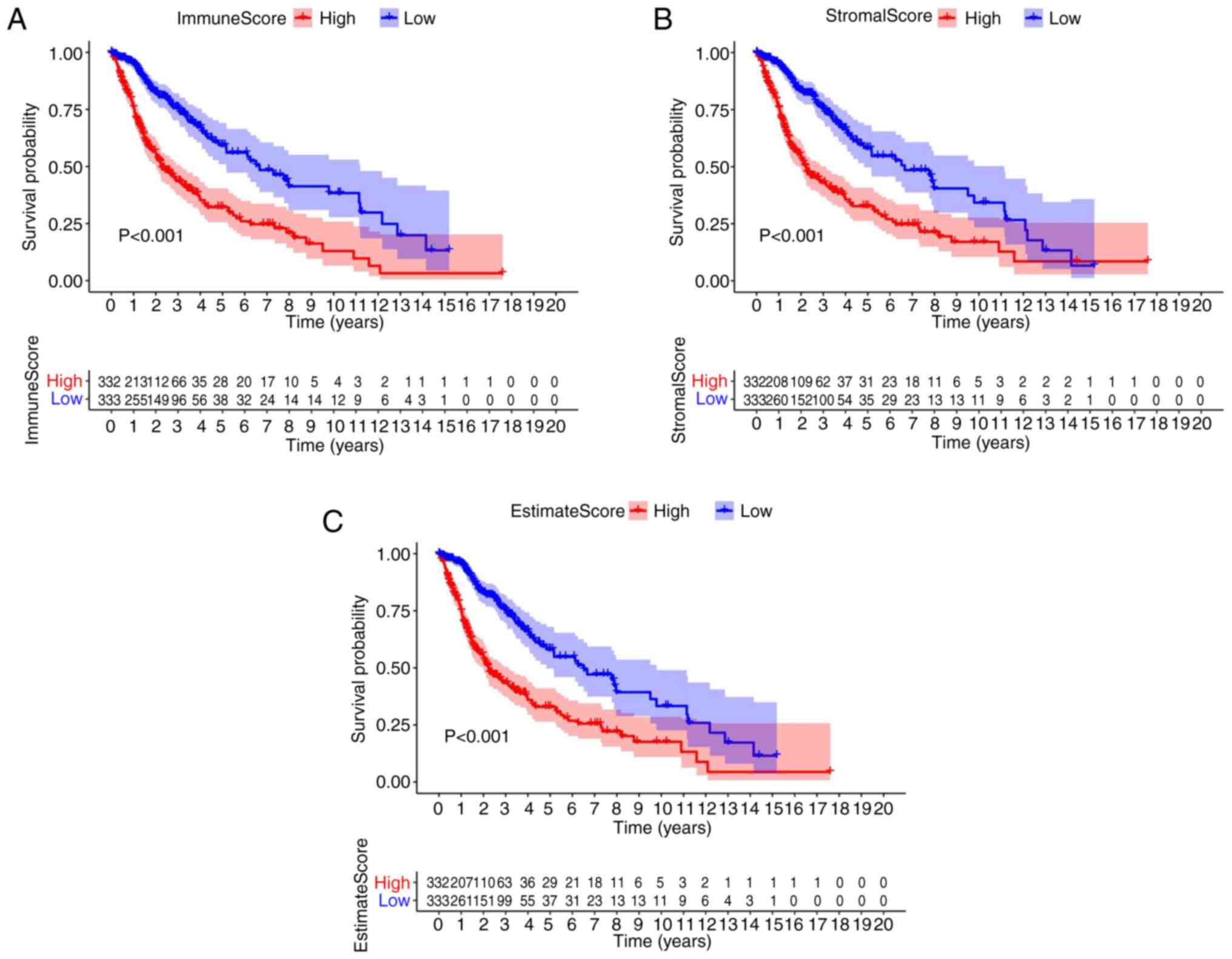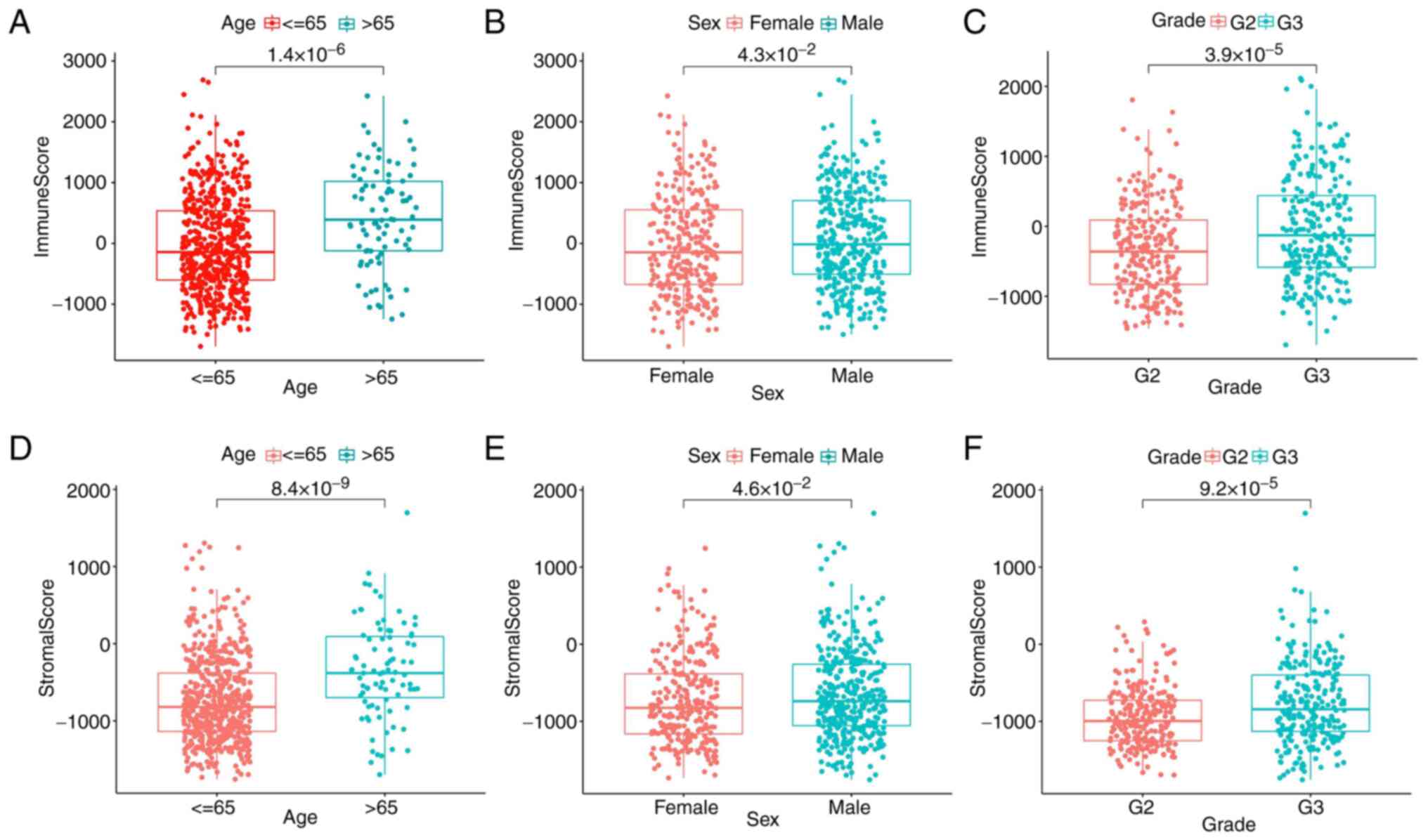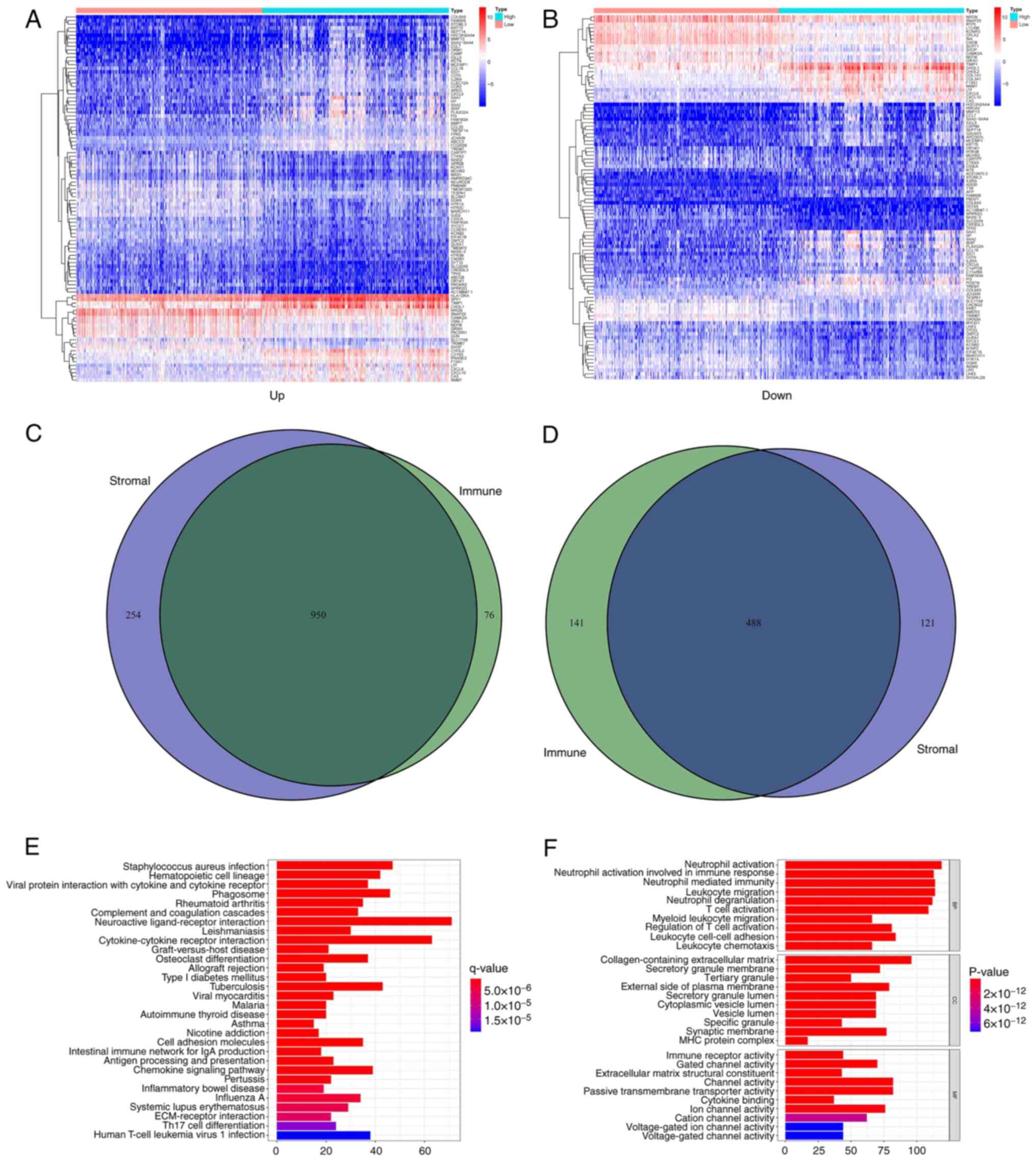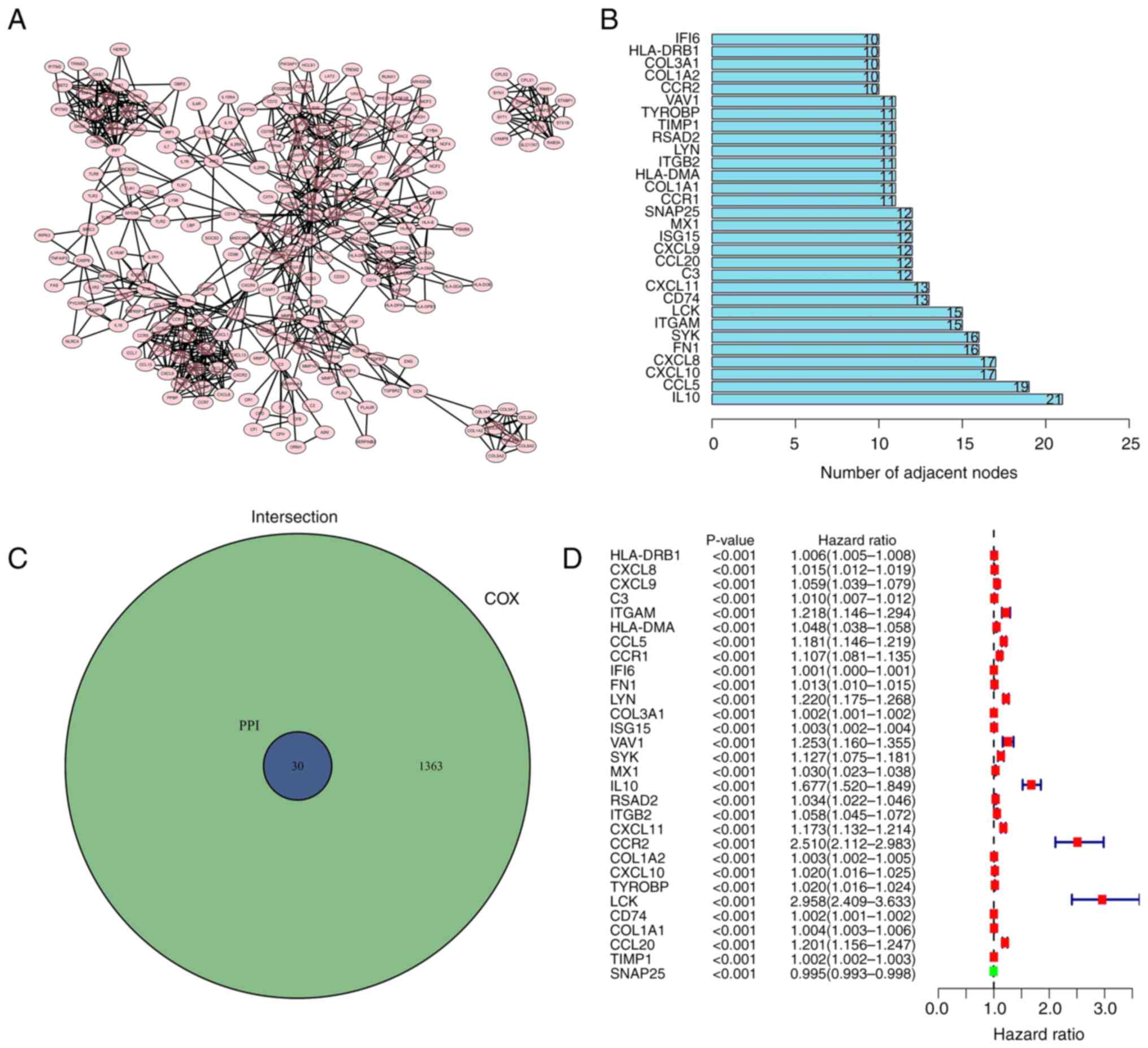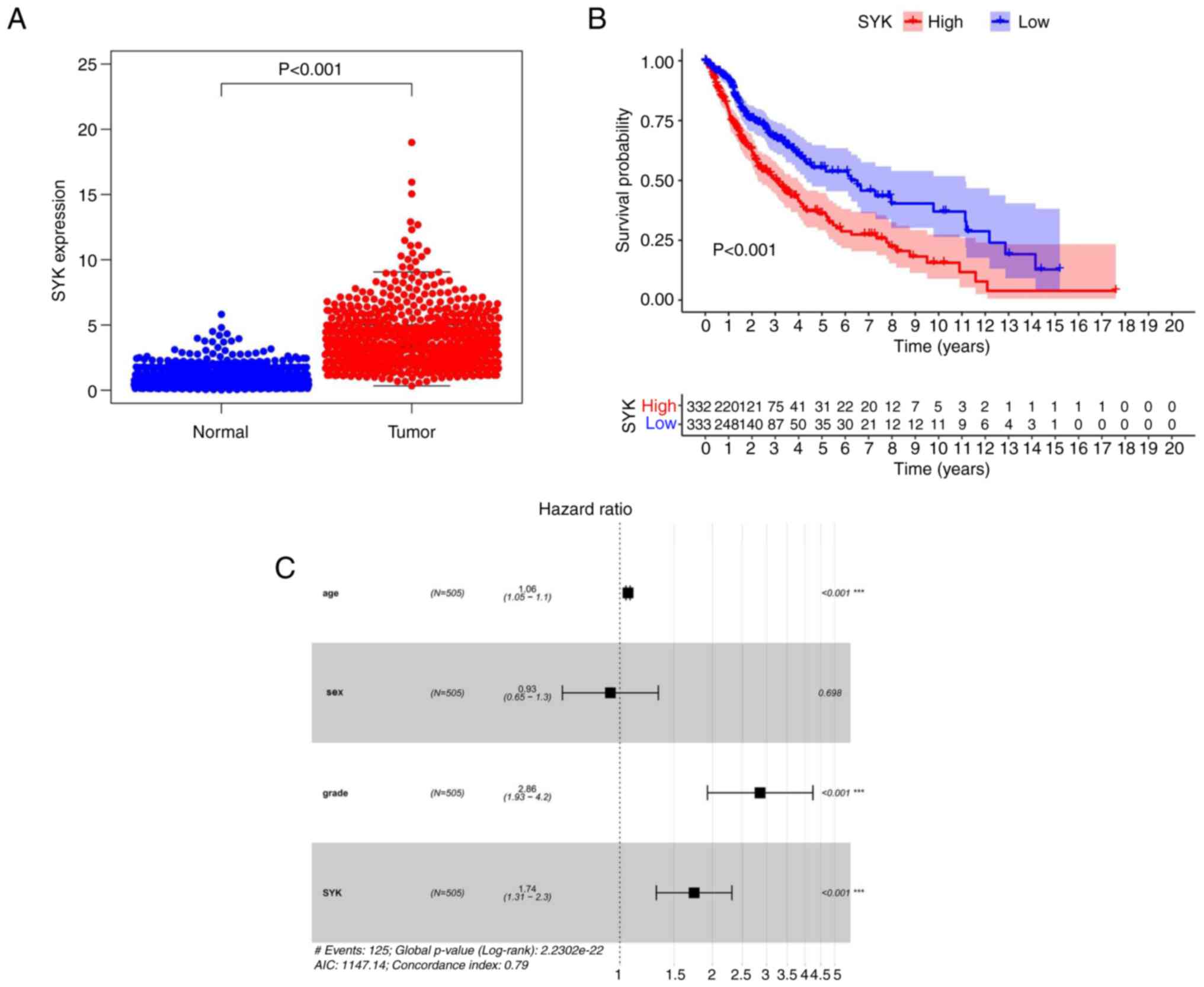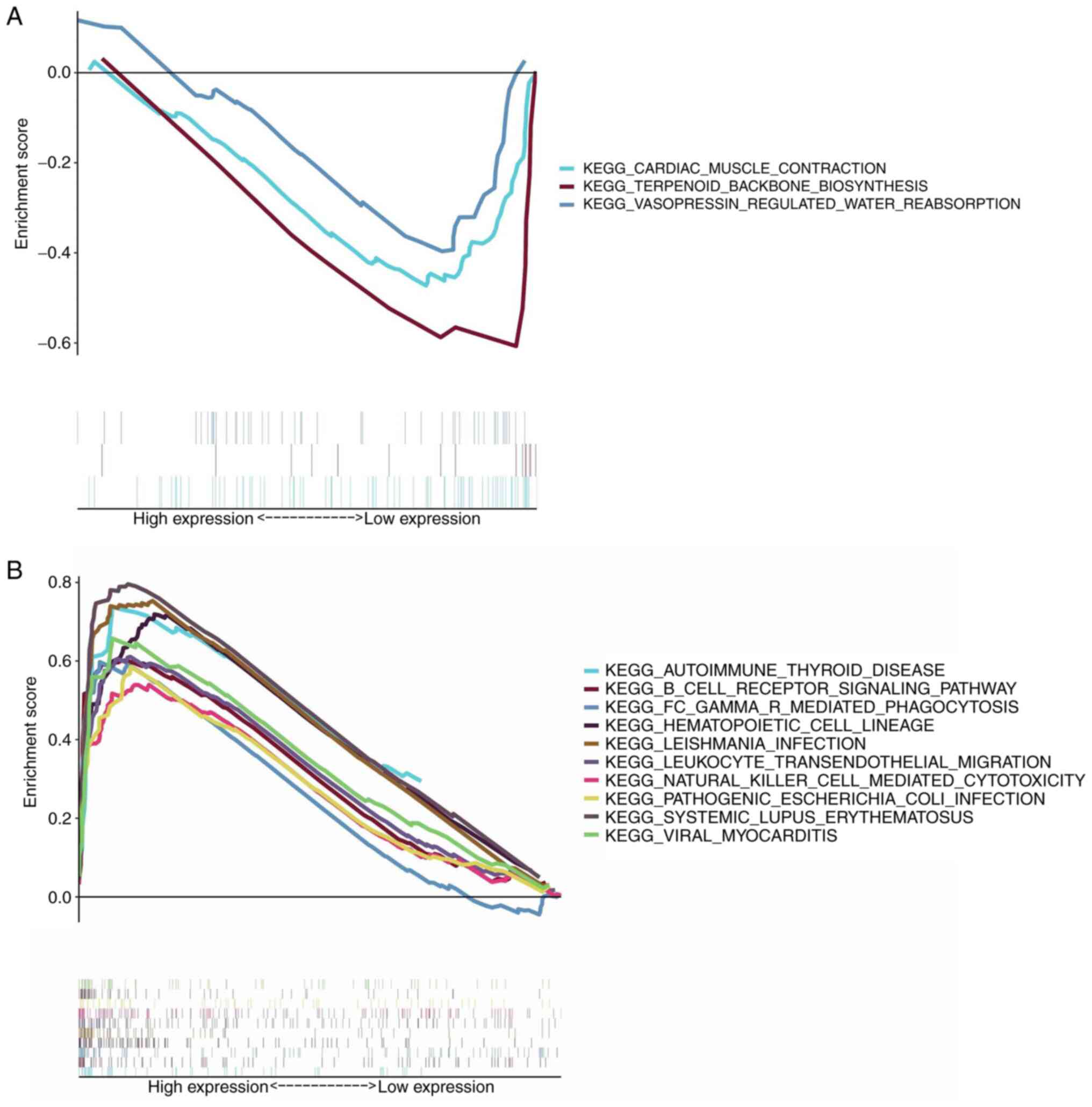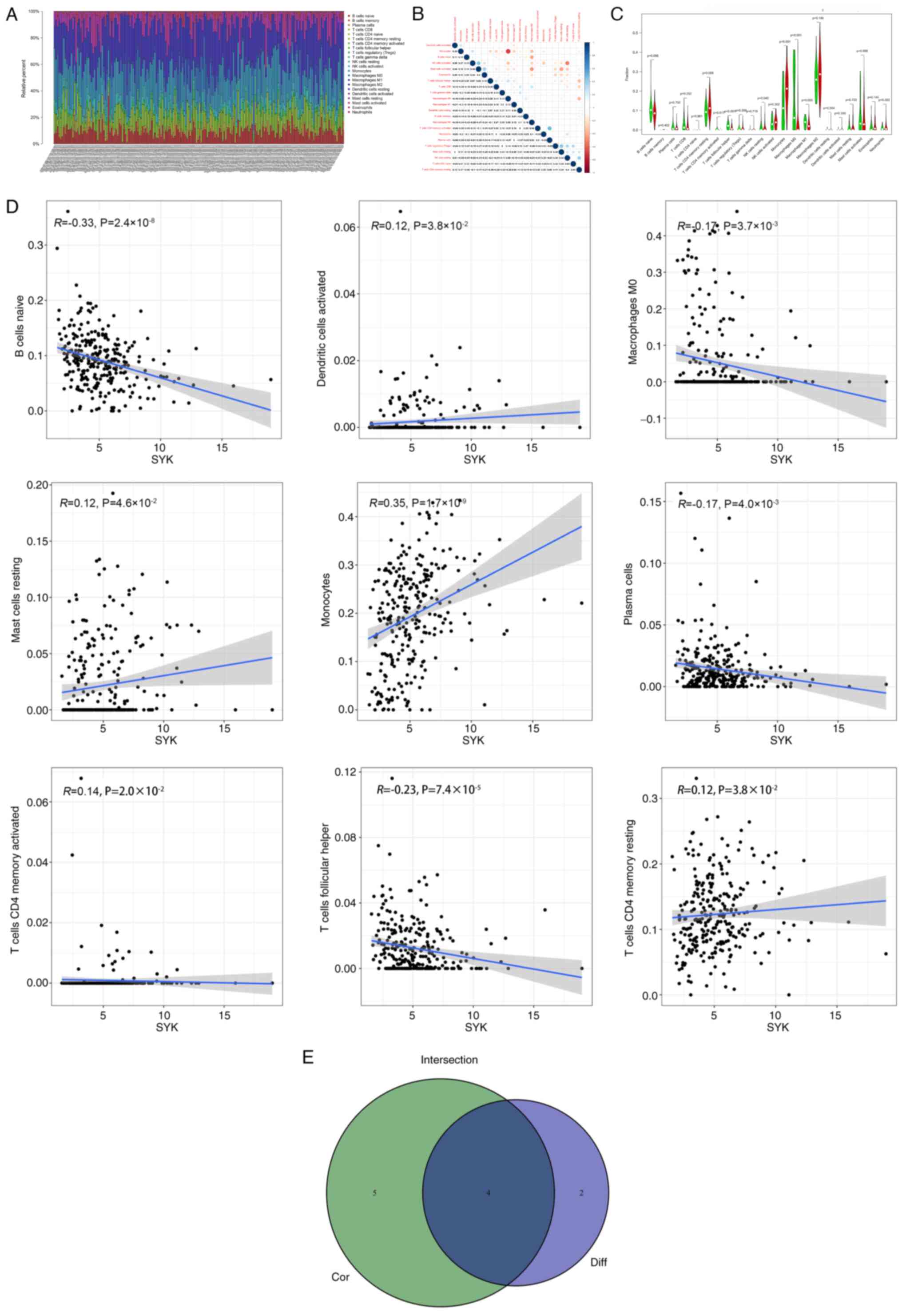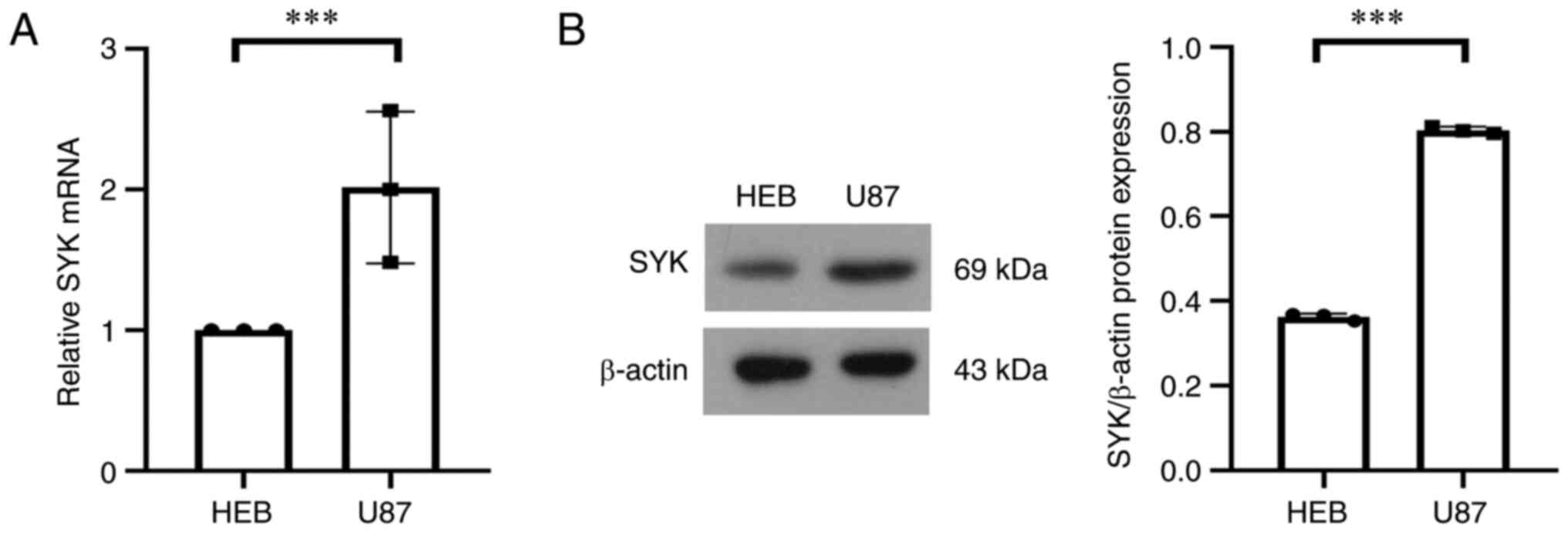Prognostic biomarker SYK and its correlation with immune infiltrates in glioma
- Authors:
- Published online on: September 7, 2023 https://doi.org/10.3892/etm.2023.12198
- Article Number: 499
-
Copyright: © Wang et al. This is an open access article distributed under the terms of Creative Commons Attribution License.
Abstract
Introduction
Among all intracranial tumors, the incidence of glioma is relatively high, accounting for ~80% of the cases with this disease (1). In addition, glioma is a challenging disease to be treated by surgery (total removal) and the prognosis is relatively poor with common recurrence of the tumor. Due to differences in age, gender and other reasons, the incidence of glioma also differs (2). In spite of the use of multimodal therapy, such as surgical excision, complete resection is considered to be impossible since a large amount of brain tissue is involved. In addition, due to the strong resistance of glioma to chemotherapy, its aggressiveness and the unique pathophysiological characteristics of the central nervous system (3), the recurrence rate of this disease approaches 100%. Therefore, screening influential prognostic factors is considered to be an effective solution to the aforementioned problems.
In addition, accumulating evidence has revealed the importance of the tumor microenvironment (TME) in the trend of tumor growth (4,5). The synergistic interaction between cancer and their supporting cells leads to the immortal status of cancer cells resulting in uncontrolled proliferation, resistance to apoptosis and evasion of immune surveillance, all of which comprise the malignant phenotypes of cancer. Therefore, the treatment response and clinical outcome of patients with cancer are significantly affected by the TME (6,7). The structural components of the TME mainly consist of host stromal cells and recruited immune cells. By studying the interaction of the TME with its various components it is possible to combine the traits of tumor cells with the TME mechanism, leading to the identification of novel biomarkers and potential drug targets for biotherapy (7). The TME mesenchyma is a genetically stable therapeutic target, unlike tumor cells that constantly mutate. The infiltrating immune cells are mainly composed of macrophages and monocytes and are deemed to exhibit tumor-promoting and immunosuppressive functions (8). The tumor-infiltrating immune cells (TICs) are markedly related to glioma cells. A previous study has indicated that the TICs of TME are a prospective indicator of a curative effect (9).
Based on bioinformatics analysis, an optimal biomarker for biological prediction was developed as a prognostic indicator. This biomarker was termed spleen tyrosine kinase (SYK), a non-receptor type of protein tyrosine kinases in the Src family (10). SYK has been widely reported in various hematopoietic malignancies and certain primary epithelial tumors as a pro-survival factor; it has been detected in several cell types, such as melanocytes, human nasal fibroblasts and liver cells (11-13). However, a limited number of reports have investigated the role of SYK in glioma (14). In the present study, it was hypothesized that SYK was also involved in the pathogenesis of glioma and that SYK intervention may be pivotal in delaying the deterioration of glioma and improve the prognosis of these patients. Therefore, an in-depth study was conducted on the differential genes between the immune and the matrix components in glioma specimens in order to explore the potential impact of this biomarker in the TME of glioma.
Materials and methods
Data preparation
The transcriptome RNA-sequencing data were available in the Genomic Data Commons (GDC) portal of The Cancer Genome Atlas (TCGA) GDC official website (https://portal.gdc.cancer.gov/). The data corresponding to 698 patients with glioma and their mRNA expression levels were obtained.
Acquisition of immune and stromal scores and Estimation of STromal and Immune cells in MAlignant Tumor tissues using Expression data (ESTIMATE) score
The ratio of the immune-stromal component of each sample in the TME was computed by the R language (version 3.6.2; r-project.org/) using ESTIMATE (15). The ratio was expressed in three different forms, including the immune score, the stromal score and the ESTIMATE score, which were positively associated with the proportion of immune and stromal cells and the sum of the two, respectively; this indicated that as the score for each component increased, their corresponding component accounted for a more significant proportion of the TME.
Survival analysis
Survival analysis was performed using the R language (version 4.0.1; https://www.r-project.org/) survival and survminer packages. The ggsurvplot function was used to plot the survival curve. A total of 510 out of 698 tumor samples had detailed survival records ranging from 0-12 years that could be selected to conduct survival analysis. The Kaplan-Meier method was used to depict the survival spline and the logarithmic rank was utilized to assess the statistical significance. P<0.05 was considered to indicate a statistically significant difference.
Discrepancy analysis of scores with clinicopathological stages
The clinical data received from the glioma samples were obtained from the TCGA database. The data were analyzed by R. In addition, Wilcoxon rank sum or Kruskal-Wallis's rank sum tests were regarded as the important tests according to the count of the clinical stages for comparison.
Heatmaps
The heatmaps of the differentially expressed genes (DEGs) were generated using the R language with package pheatmap. In this way, the results could be divided into high-expression and low-expression groups.
Analysis of DEGs in the immune and stromal scores between high-score and low-score groups
The immune and stromal scores were compared with the median scores and 698 tumor samples were marked with high or low scores. The R language with the Limma package (16) (http://www.bioconductor.org/packages/release/bioc/html/limma.html) was applied to analyze gene expression differentiation; the DEGs were obtained by comparing the high-score with the low-score samples. The log2 values obtained from the high-score compared with the low-score groups of DEGs were converted into decimals and fold change (FC). A result >1 and a false discovery rate (FDR) <0.05 were considered meaningful.
Gene Ontology (GO) and Kyoto Encyclopedia of Genes and Genomes (KEGG) enrichment analyses
The Database for Annotation, Visualization and Integrated Discovery database (http://david.ncifcrf.gov) merges biological data and analysis tools that can be used for genetic difference analysis as well as pathway enrichment. A total of 1,438 DEGs were outlined with GO and KEGG (genome.jp/) enrichment analyses using cluster profile, enrichplot and ggplot2 package in the R language. Only the results with P-value and q-value of <0.05 were considered to be markedly enriched.
Protein-protein interaction (PPI) network and Cox regression analyses
The Search Tool for the Retrieval of Interacting Genes/Proteins (STRING) database (http://string-db.org/) was employed to establish the PPI network and subsequently the Cytoscape version 3.7.2 was used to reestablish the network. The network was constructed by using nodes with the confidence of interaction >0.95. In addition, the intersection of the previous 30 genes in the PPI network was selected as an example and the univariate Cox regression study was analyzed using the survival package in R language.
Gene set enrichment analysis (GSEA)
GSEA is a reliable and practical gene analysis method (17), which confirms the correlation between the target gene required and the signal transduction pathway by ranking the target gene's high- and low-expression status. GSEA analysis included the total transcriptome of the entire tumor samples and only the gene sets with NOM P<0.05 and FDR q<0.06 were regarded as exceptional.
Cell culture
The present study used U87 as tumor cells and HEB as normal cells; HEB and U87 cells (ATCC HTB-14) were purchased from the American Type Culture Collection. The U87 cell line has been analyzed and verified by STR (Haixing Biosciences Co., Ltd). The cells were cultured at 37˚C in 5% CO2 in a mixture of DMEM (Gibco; Thermo Fisher Scientific, Inc.) with 10% FBS (Gibco; Thermo Fisher Scientific, Inc.) and cultured in an incubator WH-400 (Wiggens GmbH).
Reverse transcription-quantitative (RT)-qPCR
A total of 1x106 cells used for RT-qPCR, TRIzol® reagent (Invitrogen; Thermo Fisher Scientific, Inc.) was used for total RNA extraction, RNA reversed transcription using Takara PrimeScript RT reagent kit (Takara Biotechnology Co., Ltd.) and analyzed by RT-qPCR using Takara TB Green Premix Ex Taq II (Takara Biotechnology Co., Ltd.) in Bio-Rad iQ5 system (Bio-Rad Laboratories, Inc.). The following thermocycling conditions were used for qPCR: Initial denaturation at 95˚C for 1 min, 40 cycles at 95˚C for 5 sec, 60˚C for 30 sec and 72˚C for 20 sec. All samples used β-actin as an internal reference and the results were quantified for relative expression by the 2-ΔΔCq method (18). RNA extraction, cDNA synthesis and qPCR were performed according to the manufacturer's protocols; these experiments replicated three times. The primers were as follows: SYK forward, 5'-CTGTCGGTGGCTGCCTTTGAC-3' and reverse, 5'-TGTGGAGGGTGAGTCCTGGG-3'; β-actin forward, 5'-TGGCACCCAGCACAATGAA-3' and reverse, 5'-CTAAGTCAGAGTCCGCCTAGAAGCA-3'.
Western blotting
HEB and U87 were collected, the total cellular protein was extracted by adding RIPA lysis buffer (Beijing Solarbio Science & Technology Co., Ltd.) and the protein concentration was determined by the BCA method (Beijing Solarbio Science & Technology Co., Ltd.). The total protein (50 µg/per lane) from each sample was separated using 10% SDS-gel. The proteins were separated by sodium dodecyl sulfate-polyacrylamide gel electrophoresis (SDS-PAGE) and then transferred onto a PVDF (Roche Diagnostics GmbH). After being blocked with 5% (w/v) skimmed milk for 2 h at room temperature, followed by incubation with the primary anti-SYK antibodies (1:1,000; cat. no. A2123; ABclonal Biotech Co., Ltd.) and anti-β-actin antibodies (1:4,000; cat. no. AY0573; Shanghai Abways Biotechnology Co., Ltd.) overnight at 4˚C. Following incubation with goat anti-rabbit IgG/HRP (1:1,000; cat. no. ab131368; Abcam) and goat anti-mouse IgG/HRP conjugated secondary antibodies (1:1,000; cat. no. SE131; Beijing Solarbio Science & Technology Co., Ltd.) for 2 h at room temperature, targeted bands were developed using the BeyoECL Plus kit (MilliporeSigma) and the grayscale values of each band were analyzed by Image J software (version 2.0, National Institutes of Health) and assessed semiquantitatively.
Statistical analysis
Experiments were statistically evaluated using GraphPad Prism 8.0 (GraphPad Software, Inc.) and the results are presented as mean ± standard deviation (SD). Unpaired Student's t-test was used to evaluate differences between groups. Pearson's correlation coefficient was utilized to analyze the correlation. P<0.05 was considered to indicate a statistically significant difference.
Results
Association of survival with the score of patients with glioma
To ascertain the association between immune and stromal estimate ratio and the survival rate, survival analysis was performed for the immune score, stromal score, as well as for the ESTIMATE score, using the Kaplan-Meier survival analysis. The counts of the immune or stromal components of the TME were expressed as estimates in the immune score or stromal score. In comparison with the median, patients with glioma were segmented into high and low groups. The results indicated that the scores of the immune and stromal cell contents were markedly associated with the survival of patients with glioma (Fig. 1A-C). In brief, the data revealed that the immune, stromal and estimate components of the TME were more appropriate indicators of the prognosis in patients with glioma (P<0.01).
Association of the score with the clinicopathological stage of patients with glioma
The clinical information of patients with glioma in the TCGA database was obtained to ascertain the association between immune and stromal components and the clinicopathological traits. The results found that the immune scores of patients >65 years were significantly higher than those of patients <65 years (Fig. 2A) and the immune scores of patients with G3 grade were significantly higher than those of G2 grade (Fig. 2C). It was noteworthy that there was little association with sex. However, stromal scores were positively associated with tumor age and grade (Fig. 2D and F), sex had less influence on stromal scores (Fig. 2E). All the results further indicated that the quantity of immune and stromal components was relevant to glioma evolution, such as age and grade. However, there was little association with sex.
The DEGs shared by the immune and stromal scores are principally enriched in immune-related genes
Comparative analyses of high- and low-score samples were performed to ensure the substantial variation in the gene profiles of the immune and stromal components of the TME. Compared with the median, 1,655 DEGs were selected in the high- and low-score samples of the immune score. A total of 1,026 upregulated and 629 downregulated genes were identified in all gene sets (Fig. 3A, C and D). By analogy, 1,813 DEGs were acquired in the stromal score, with 1,204 upregulated and 609 downregulated genes (Fig. 3B and D). The intersecting point analysis of the Venn plot indicated that 950 upregulated genes overlapped in the aggregate in the immune score and stromal score analysis, whereas 488 downregulated genes overlapped in the same type of analysis. These genes (a total of 1,438 genes) may influence the status of the TME. During KEGG enrichment analysis, neuroactive ligand-receptor interaction, cytokine-cytokine receptor interaction and tuberculosis enrichment were shown (Fig. 3E). From GO enrichment analysis, it was concluded that the DEGs identified were mainly consistent with the GO terms regarding immunity. For example, the terms neutrophil activation, neutrophil-mediated immunity and leukocyte migration were highlighted (Fig. 3F). Therefore, the entire function in DEGs was seemingly connected with immune-related activities, which confirmed that the existence of immune factors had an influence on the TME of patients with glioma.
Intersection analysis of the PPI network and univariate Cox regression analysis
To investigate whether protein interactions /Users/e.kouneni/Downloads/ETM-19384-290776/FIG.3.tif
were present among the 1,438 DEGs, the PPI network was established using Cytoscape software (3.7.2) according to the STRING database
Fig. 4A displays the interaction between genes (confidence interval 0.95); the bar chart indicates the previous 30 genes permutated by the count of nodes (Fig. 4B). A total of 30 genes were intersected and screened in the PPI and the genes with a P-value of <0.05 were selected by the univariate Cox regression analysis (Fig. 4C). To determine the risk value among the 30 factors, a univariate Cox regression analysis was performed on patients with glioma. Fig. 4D indicated that only a limited number of genes exhibited low-risk values.
Association between survival analysis and SYK expression in patients with glioma
The risk genes (ITGAM; CCL5; CCR1; LYN; SYK; VAV1; IL10; CXCL11; CCR2; LCK and CCL20) were selected through intersection analysis of the PPI network and univariate Cox regression analysis. SYK ranked in the top five of genes identified in the intersection analysis of the PPI network. SYK demonstrated significance in the univariate Cox regression analysis. The genes were queried one by one using gene card (https://www.genecards.org). The analysis indicated that SYK demonstrated a significant association with the occurrence and development of tumors (19). SYK has been extensively studied in the occurrence and development of breast, pancreatic and colon cancers, as well as in the development of other types of tumor. However, the studies that have examined its role in glioma are not in-depth analyses (20-22). SYK was finally selected. The data obtained from the TCGA database indicated that SYK expression was significantly increased in the tumor group compared with that noted in the normal tissue group (P<0.001; Fig. 5A). Survival analysis of SYK indicated that the survival rate of patients with glioma and low SYK expression was apparently higher compared with that noted in patients with glioma and high SYK expression. Moreover, the entire survival of tumor patients was apparently reduced (Fig. 5B). Multivariate Cox survival analysis confirmed that a high SYK expression level was an autocephalous predictor of undesirable prognosis in patients with glioma (P<0.001). The results indicated that SYK was a high-risk gene in glioma (Fig. 5C). In summary, these results indicated that SYK exhibited a significantly higher expression in glioma samples compared with that noted in standard samples; its expression was an autocephalous predictor of undesirable prognosis in patients with glioma.
SYK may be an indicator of TME regulation
Since SYK levels were inversely associated with the survival of patients with glioma, their data were divided into high-expression and low-expression groups and subsequently severally contrasted to the median level of SYK expression in GSEA. As shown in Fig. 6A, almost no gene set enrichment was noted in the low-expression group of SYK. The SYK high-expression group was principally enriched in immune-related activities. For example, the B cell receptor signaling pathway, the hematopoietic cell lineage and the autoimmune thyroid disease were the main enriched pathways (Fig. 6B). The aforementioned results revealed that SYK could be a potential indicator of the TME status.
Correlation between SYK expression and the ratio of TICs
To further verify the association between the expression of SYK and the immune microenvironment, the ratio of tumor-infiltrating immune subsets was analyzed by utilizing the CIBERSORT algorithm. A spectrum of 22 immune cells was established in glioma samples (Fig. 7A and B). The immune cell difference analysis results indicated that six different immune cells were associated with the expression of SYK (Fig. 7C). The immune cell correlation analysis results indicated that nine different immune cells were associated with the expression of SYK (Fig. 7D). The difference and correlation analyses indicated that four different immune cells were associated with SYK expression. Among them, two types of immune cells positively correlated with SYK expression, which comprised cluster of differentiation (CD) 4 memory resting T cells and monocytes and two different types of immune cells were inversely associated with SYK expression, including T follicular helper cells and macrophages M0 (Fig. 7E). These results demonstrated the contribution of SYK in modulating the immune response and playing a crucial role in the development of the TME.
The expression of SYK is associated with glioma
According to the results of the present study, the expression of SYK was closely associated with glioma. The expression of SYK in tumor cells and normal cells was verified by using western blot and RT-qPCR and the results showed that the expression level of SYK in tumor cells was significantly higher compared with that in normal cells (Fig. 8A and B). These results further proved that the high expression of SYK was closely associated with the development of glioma in terms of protein expression and gene expression.
Discussion
In the present study, the data derived from the TCGA database were used to determine the TME genes associated with survival in patients with glioma. By using Cox regression analysis, SYK was finally identified from the list of DEGs to be closely associated with the survival of patients with glioma. SYK was shown to participate in immunization processes. Eventually, SYK was confirmed to be a preponderant target of the TME status for patients with glioma by a series of bioinformatics analyses.
During tumor occurrence and development, the TME is always in effect. Therefore, the exploration of the latent remedial targets of TME refactoring and the further induction of the TME-related changes from a tumor-friendly to a tumor-suppressive phenotype is required for conducting valuable research. Previous studies have shown that the occurrence of tumors is markedly associated with the immune microenvironment (23,24). In the transcriptional analysis of glioma, the analysis of the data downloaded from the TCGA database indicated that the immune component of the TME exhibited a particular effect on the postoperative predictive outcomes of the patients. In particular, the evolution in glioma (such as intrusion and transfer) was associated with the quantity of immune and stromal components in the TME. The aforementioned analysis indicated the importance of investigating the mutual effect of tumor and immune cells, which can provide new directions for developing more promising treatment options.
Following systematic analysis, the most significant gene, SYK, was identified to be responsible for the survival of patients with glioma. SYK is a pivotal member in the immune cell signaling pathways as it modulates proliferation, differentiation and cell survival by activating a series of signal transduction pathways, such as an element of immune receptor signal transduction (25,26). In addition, SYK is a crucial part of the B lymphocyte signaling receptor (27) and it can regulate a variety of biological functions of B lymphocytes; it is also closely connected with the activation and maturation of B cells (12). The lack of SYK expression, which is involved in the TME, leads to impaired development and maturation of immune cells and, in severe cases, to severe combined immunodeficiency disease. Therefore, in the presence of mutations, abnormal proliferation of cells occurs, which leads to the loss of immunity and eventually to tumor development (28). Several studies have investigated the function of SYK inhibitors. Entospletinib, an inhibitor of SYK, has shown promising results in clinical trials performed for the treatment of B cell malignancies (29,30). In addition, several oral SYK inhibitors have already been evaluated in clinical trials, including fostamatinib (R788), entospletinib (GS-9973) and TAK-659 (31-33). It has been shown that SYK inhibition can block the propagation and migration of glioma cells in vitro (14). Furthermore, SYK may be involved in the regulation of macrophage polarization in TME (34). Therefore, a deeper analysis of the relationship in SYK expression and the TME was performed. Certain immune-related signaling pathways were identified by GSEA analysis. For example, FC gamma R-mediated phagocytosis, the B cell receptor signaling pathway and the hematopoietic cell lineage pathway were markedly enriched in the SYK high-expression group. The violin plot indicated that the number of T cell CD4 memory resting, monocytes and M2 macrophages in the SYK high-expression group was higher compared with that of the SYK low-expression group, which revealed that the expression of SYK was closely associated with the number of immune cells in the TME. Macrophages are roughly segmented into M1 and M2 genres according to their functions. The M1 macrophages participate in the inflammatory response, pathogen clearance and antitumor immunity. Nevertheless, the M2 macrophages are different from M1 and they influence the anti-inflammatory response, the wound healing process and the pro-tumorigenic properties (35,36). As depicted in the violin diagram, the number of M1 macrophages was lower and that of M2 was higher in the high-expression group of SYK, further supporting the possibility that SYK may take part in the tumor-promoting properties of glioma.
The current study suggested that SYK may affect the proliferation and migration of glioma cells by affecting the B cell receptor signaling pathways and the hematopoietic cell lineage. In summary, SYK is a potential cancer-promoting gene and it is expected to be a new target for the treatment of glioma; it may also provide new ideas for the therapy of glioma. Therefore, the accuracy of the combined analysis requires further investigation to define SYK expression, tumor-infiltrating B cell subtypes and mutagen-driven patterns prior to the treatment of patients with glioma with SYK inhibitors. However, the present study lacks glioblastoma tumor tissues and the immunological role and specific mechanisms of SYK in glioma have not been explored in depth. The role of SYK and its mechanism in glioma will continue to be explored through cell experiments and animal experiments in the future.
Acknowledgements
Not applicable.
Funding
Funding: This study was supported by the Natural Science Foundation of Shandong Province, China (grant no. ZR202102190696).
Availability of data and materials
The datasets generated and/or analyzed during the current study are available in the TCGA database (https://portal.gdc.cancer.gov).
Authors' contributions
CW, PL and YS performed the experiments and wrote the manuscript. TL, XX and JG searched the literature and analyzed the data. HS and ZG searched the literature and revised the manuscript. RX designed the experiments and revised the manuscript. All authors read and approved the final manuscript. CW and RX confirm the authenticity of all the raw data.
Ethics approval and consent to participate
Not applicable.
Patient consent for publication
Not applicable.
Competing interests
The authors declare that they have no competing interests.
References
|
Ostrom QT, Bauchet L, Davis FG, Deltour I, Fisher JL, Langer CE, Pekmezci M, Schwartzbaum JA, Turner MC, Walsh KM, et al: The epidemiology of glioma in adults: A ‘state of the science’ review. Neuro Oncol. 16:896–913. 2014.PubMed/NCBI View Article : Google Scholar | |
|
Gigineishvili D, Shengelia N, Shalashvili G, Rohrmann S, Tsiskaridze A and Shakarishvili R: Primary brain tumour epidemiology in Georgia: First-year results of a population-based study. J Neurooncol. 112:241–246. 2013.PubMed/NCBI View Article : Google Scholar | |
|
Lee E, Yong RL, Paddison P and Zhu J: Comparison of glioblastoma (GBM) molecular classification methods. Semin Cancer Biol. 53:201–211. 2018.PubMed/NCBI View Article : Google Scholar | |
|
Hinshaw DC and Shevde LA: The tumor microenvironment innately modulates cancer progression. Cancer Res. 79:4557–4566. 2019.PubMed/NCBI View Article : Google Scholar | |
|
Roma-Rodrigues C, Mendes R, Baptista PV and Fernandes AR: Targeting tumor microenvironment for cancer therapy. Int J Mol Sci. 20(840)2019.PubMed/NCBI View Article : Google Scholar | |
|
Quail DF and Joyce JA: Microenvironmental regulation of tumor progression and metastasis. Nat Med. 19:1423–1437. 2013.PubMed/NCBI View Article : Google Scholar | |
|
Wood SL, Pernemalm M, Crosbie PA and Whetton AD: The role of the tumor-microenvironment in lung cancer-metastasis and its relationship to potential therapeutic targets. Cancer Treat Rev. 40:558–566. 2014.PubMed/NCBI View Article : Google Scholar | |
|
Tomaszewski W, Sanchez-Perez L, Gajewski TF and Sampson JH: Brain tumor microenvironment and host state: Implications for immunotherapy. Clin Cancer Res. 25:4202–4210. 2019.PubMed/NCBI View Article : Google Scholar | |
|
Mollaoglu G, Jones A, Wait SJ, Mukhopadhyay A, Jeong S, Arya R, Camolotto SA, Mosbruger TL, Stubben CJ, Conley CJ, et al: The lineage-defining transcription factors SOX2 and NKX2-1 determine lung cancer cell fate and shape the tumor immune microenvironment. Immunity. 49:764–779. 2018.PubMed/NCBI View Article : Google Scholar | |
|
Liu P, Guo J, Xu X, Sun H and Gong Z: Prognostic biomarker SYK and its correlation with immune infiltrates in glioma. https://doi.org/10.21203/rs.3.rs-839283/v1. | |
|
Deng GM, Kyttaris VC and Tsokos GC: Targeting syk in autoimmune rheumatic diseases. Front Immunol. 7(78)2016.PubMed/NCBI View Article : Google Scholar | |
|
Mócsai A, Ruland J and Tybulewicz VL: The SYK tyrosine kinase: A crucial player in diverse biological functions. Nat Rev Immunol. 10:387–402. 2010.PubMed/NCBI View Article : Google Scholar | |
|
Krisenko MO and Geahlen RL: (2015) Calling in SYK: SYK's dual role as a tumor promoter and tumor suppressor in cancer. Biochim Biophys Acta. 1853:254–263. 2010. | |
|
Moncayo G, Grzmil M, Smirnova T, Zmarz P, Huber RM, Hynx D, Kohler H, Wang Y, Hotz HR, Hynes NE, et al: SYK inhibition blocks proliferation and migration of glioma cells and modifies the tumor microenvironment. Neuro Oncol. 20:621–631. 2018.PubMed/NCBI View Article : Google Scholar | |
|
Robin X, Turck N, Hainard A, Tiberti N, Lisacek F, Sanchez JC and Müller M: pROC: An open-source package for R and S+ to analyze and compare ROC curves. BMC Bioinformatics. 12(77)2011.PubMed/NCBI View Article : Google Scholar | |
|
Ritchie ME, Phipson B, Wu D, Hu Y, Law CW, Shi W and Smyth GK: Limma powers differential expression analyses for RNA-sequencing and microarray studies. Nucleic Acids Res. 43(e47)2015.PubMed/NCBI View Article : Google Scholar | |
|
Subramanian A, Kuehn H, Gould J, Tamayo P and Mesirov JP: GSEA-P: A desktop application for gene set enrichment analysis. Bioinformatics. 23:3251–3253. 2007.PubMed/NCBI View Article : Google Scholar | |
|
Livak KJ and Schmittgen TD: Analysis of relative gene expression data using real-time quantitative PCR and the 2(-Delta Delta C(T)) method. Methods. 25:402–408. 2001.PubMed/NCBI View Article : Google Scholar | |
|
Yu Y, Rahmanto YS, Lee MH, Wu PH, Phillip JM, Huang CH, Vitolo MI, Gaillard S, Martin SS, Wirtz D, et al: Inhibition of ovarian tumor cell invasiveness by targeting SYK in the tyrosine kinase signaling pathway. Oncogene. 37:3778–3789. 2018.PubMed/NCBI View Article : Google Scholar | |
|
Repana K, Papazisis K, Foukas P, Valeri R, Kortsaris A, Deligiorgi E and Kyriakidis D: Expression of Syk in invasive breast cancer: Correlation to proliferation and invasiveness. Anticancer Res. 26:4949–4954. 2006.PubMed/NCBI | |
|
Layton T, Stalens C, Gunderson F, Goodison S and Silletti S: Syk tyrosine kinase acts as a pancreatic adenocarcinoma tumor suppressor by regulating cellular growth and invasion. Am J Pathol. 175:2625–2636. 2009.PubMed/NCBI View Article : Google Scholar | |
|
Shakeel S, Mahjabeen I, Kayani MA and Faryal R: Association of SYK genetic variations with breast cancer pathogenesis. Asian Pac J Cancer Prev. 14:3309–3314. 2013.PubMed/NCBI View Article : Google Scholar | |
|
Qian Y, Zhai E, Chen S, Liu Y, Ma Y, Chen J, Liu J, Qin C, Cao Q, Chen J and Cai S: Single-cell RNA-seq dissecting heterogeneity of tumor cells and comprehensive dynamics in tumor microenvironment during lymph nodes metastasis in gastric cancer. Int J Cancer. 151:1367–1381. 2022.PubMed/NCBI View Article : Google Scholar | |
|
Xiao Y and Yu D: Tumor microenvironment as a therapeutic target in cancer. Pharmacol Ther. 221(107753)2021.PubMed/NCBI View Article : Google Scholar | |
|
Taniguchi T, Kobayashi T, Kondo J, Takahashi K, Nakamura H, Suzuki J, Nagai K, Yamada T, Nakamura S and Yamamura H: Molecular cloning of a porcine gene syk that encodes a 72-kDa protein-tyrosine kinase showing high susceptibility to proteolysis. J Biol Chem. 266:15790–15796. 1991.PubMed/NCBI | |
|
Qu C, Zheng D, Li S, Liu Y, Lidofsky A, Holmes JA, Chen J, He L, Wei L, Liao Y, et al: Tyrosine kinase SYK is a potential therapeutic target for liver fibrosis. Hepatology. 68:1125–1139. 2018.PubMed/NCBI View Article : Google Scholar | |
|
Feng G and Wang X: Role of spleen tyrosine kinase in the pathogenesis of chronic lymphocytic leukemia. Leuk Lymphoma. 55:2699–2705. 2014.PubMed/NCBI View Article : Google Scholar | |
|
Sada K, Takano T, Yanagi S and Yamamura H: Structure and function of Syk protein-tyrosine kinase. J Biochem. 130:177–186. 2001.PubMed/NCBI View Article : Google Scholar | |
|
Wang X, Guo J, Ning Z and Wu X: Discovery of a natural syk inhibitor from chinese medicine through a docking-based virtual screening and biological assay study. Molecules. 23(3114)2018.PubMed/NCBI View Article : Google Scholar | |
|
Poe JC, Jia W, Di Paolo JA, Reyes NJ, Kim JY, Su H, Sundy JS, Cardones AR, Perez VL, Chen BJ, et al: (2018) SYK inhibitor entospletinib prevents ocular and skin GVHD in mice. JCI Insight. 3(122430)2018.PubMed/NCBI View Article : Google Scholar | |
|
Singh R, Masuda ES and Payan DG: Discovery and development of spleen tyrosine kinase (SYK) inhibitors. J Med Chem. 55:3614–3643. 2012.PubMed/NCBI View Article : Google Scholar | |
|
Chen L, Monti S, Juszczynski P, Daley J, Chen W, Witzig TE, Habermann TM, Kutok JL and Shipp MA: SYK-dependent tonic B-cell receptor signaling is a rational treatment target in diffuse large B-cell lymphoma. Blood. 111:2230–2237. 2008.PubMed/NCBI View Article : Google Scholar | |
|
Koerber RM, Held SAE, Heine A, Kotthoff P, Daecke SN, Bringmann A and Brossart P: Analysis of the anti-proliferative and the pro-apoptotic efficacy of Syk inhibition in multiple myeloma. Exp Hematol Oncol. 4(21)2015.PubMed/NCBI View Article : Google Scholar | |
|
Joshi S, Liu KX, Zulcic M, Singh AR, Skola D, Glass CK, Sanders PD, Sharabi AB, Pham TV, Tamayo P, et al: Macrophage Syk-PI3Kγ inhibits antitumor immunity: SRX3207, a novel dual Syk-PI3K inhibitory chemotype relieves tumor immunosuppression. Mol Cancer Ther. 19:755–764. 2020.PubMed/NCBI View Article : Google Scholar | |
|
Mills CD, Kincaid K, Alt JM, Heilman MJ and Hill AM: M-1/M-2 macrophages and the Th1/Th2 paradigm. J Immunol. 164:6166–6173. 2000.PubMed/NCBI View Article : Google Scholar | |
|
Chanmee T, Ontong P, Konno K and Itano N: Tumor-associated macrophages as major players in the tumor microenvironment. Cancers (Basel). 6:1670–1690. 2000.PubMed/NCBI View Article : Google Scholar |



